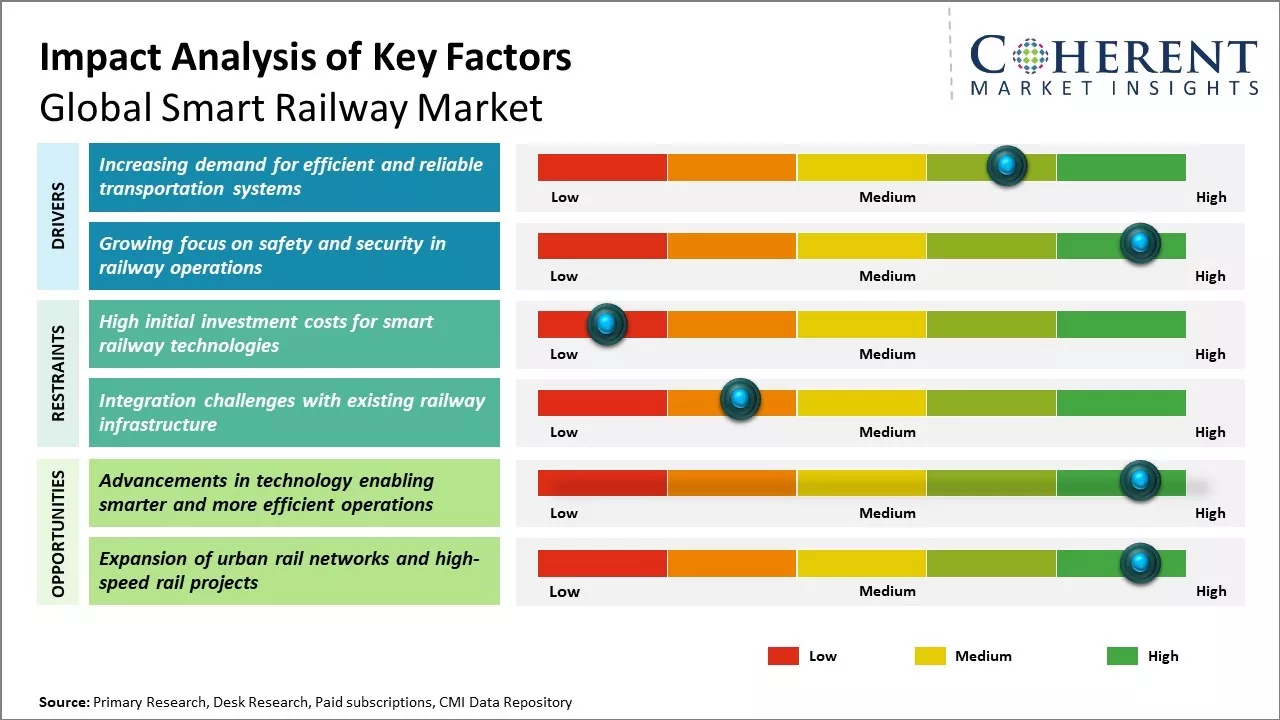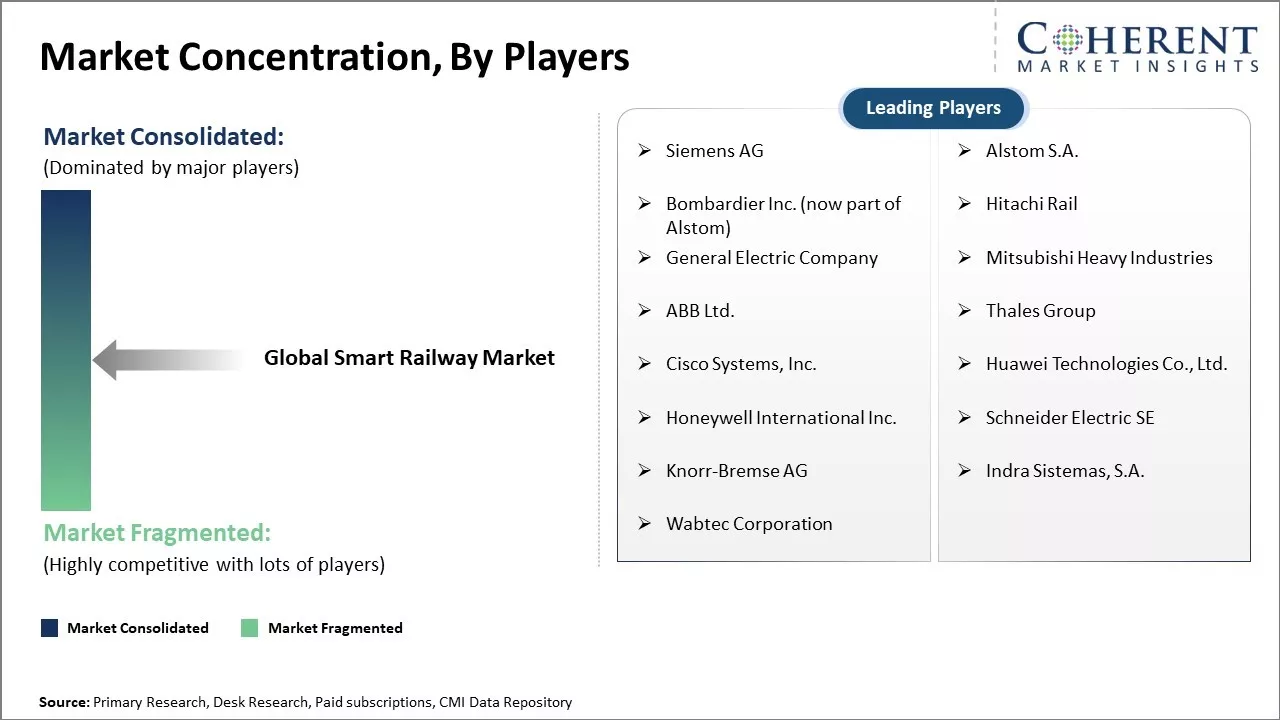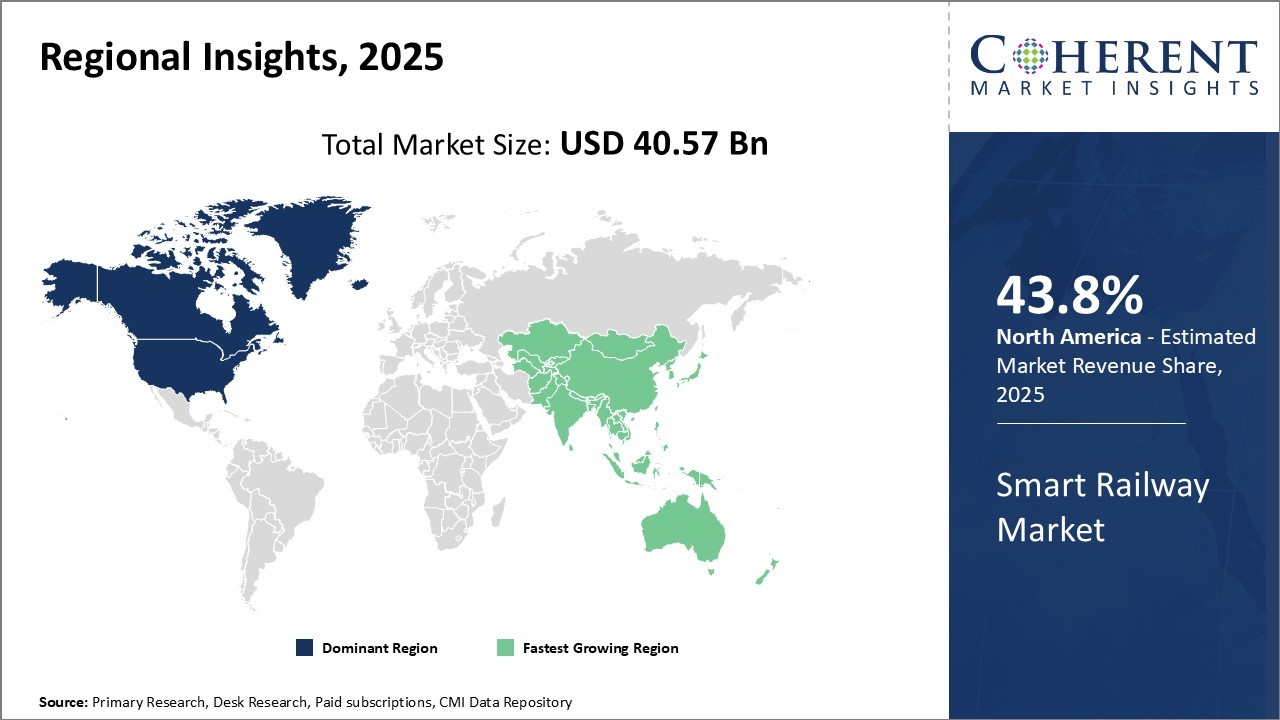The smart railway market is estimated to be valued at USD 40.57 Bn in 2025 and is expected to reach USD 85.90 Bn by 2032, exhibiting a compound annual growth rate (CAGR) of 11.3% from 2025 to 2032.

To learn more about this report, Download Free Sample
The global smart railway market is expected to witness substantial growth driven by factors such as increasing need for optimization of transportation processes, rising preference for enhanced passenger experience and safety, and growing demand for energy-efficient transportation solutions. Integration of advanced technologies such as artificial intelligence, IoT, and 5G networks to enhance railway operations is anticipated to present significant opportunity in the market.
However, high initial costs associated with smart railway projects may hamper market growth. Overall, digitization of rail networks is expected to be a key trend shaping the future of the industry.

To learn more about this report, Download Free Sample
|
Current Events |
Description and its impact |
|
Geopolitical and Regulatory Developments in Europe |
|
|
Economic Challenges and Supply Chain Constraints Globally |
|
Uncover macros and micros vetted on 75+ parameters: Get instant access to report
Government initiatives and strategic investments in railway infrastructure modernization have become key drivers propelling the smart railway market across global transportation networks. Countries around the world are increasingly recognizing the urgent need to upgrade rail systems to meet the demands of rapid urbanization, environmental sustainability, and efficient mass transit solutions.
For instance, in June 2025, initiatives such as the Dedicated Freight Corridor (DFC) project and the modernization of existing railway stations underscore the government's commitment to improving efficiency, safety, and connectivity within the railway sector.
In terms of service type, the integration segment is estimated to contribute the highest market share of 52.2% in 2025, owing to growing emphasis on connectivity.
Railway operators are under increasing pressure to provide seamless travel experiences to passengers. This has driven focus onto establishing integrated digital infrastructure and platforms. Integration services help transport authorities consolidate fragmented systems for ticketing, passenger information, train scheduling and others. This allows real-time data sharing between previously distinct functions.
In terms of technology, the IoT solutions segment is estimated to contribute the highest market share of 32.9% in 2025, due to transforming industry workflows.
Internet of Things (IoT) systems connect myriad physical assets to collect operational data. This brings unprecedented insights into resource optimization and predictive maintenance. For instance, sensors on trains, tracks, and signals feed information on fuel usage, dwell times, traffic conditions in real-time. Armed with these actionable inputs, managers can make quick, informed decisions.
In terms of application, the passenger information systems segment is estimated to contribute the highest market share of 37.6% in 2025, owing to importance of traveling public.
Railroads rely heavily on fares from individual commuters and long-distance passengers. Thus, it is increasingly crucial to offer engaging, informative experiences. Passenger information systems connect directly with customers through digital displays, websites and mobile apps. Real-time updates on schedules, platform changes, service advisories help manage expectations. Features like e-ticketing, loyalty programs and destination guide also aim to simplify travel.
Artificial Intelligence (AI) is revolutionizing the smart railway market by enhancing operational efficiency, safety, and passenger experience. Railways worldwide are increasingly leveraging AI technologies to optimize systems and services, making transportation smarter, faster, and more reliable.

To learn more about this report, Download Free Sample
North America is expected to emerge as the dominant region in the global smart railway market, accounting for a 43.8% share in 2025. The region has made significant investments in deploying advanced signaling and communication systems across its rail networks. These upgrades have improved safety, optimized operational efficiency, and enhanced the overall passenger experience.
For instance, in October 2024, the U.S. Department of Transportation’s (USDOT) Federal Railroad Administration (FRA) announced over USD 2.4 billion in Bipartisan Infrastructure Law funding for 122 rail improvement projects across 41 states and Washington, D.C. These initiatives aim to make rail transportation safer, more reliable, and more resilient—helping move goods and people more efficiently while reducing disruptions, shipping costs, and environmental impact.
The Asia Pacific region has experienced the fastest growth in the smart railway market in recent years. Rapid urbanization and industrialization have driven large-scale railway infrastructure development across major countries such as China, India, and Japan. These nations are actively investing in high-speed rail corridors, intelligent signaling systems, and digital platforms to alleviate congestion and enhance transportation efficiency.
For instance, China’s national railways transported approximately 1.3 billion ton of cargo between January and April 2025—a 3.6% year-on-year increase—according to China State Railway Group Co., Ltd. This growth reflects the country’s efforts to modernize freight operations through smart railway technologies that improve efficiency and optimize network performance.
China is a global leader in smart railway development, backed by large-scale investments, strong government support, and rapid technological adoption. The country has prioritized building high-speed rail corridors, automated freight logistics, and integrating intelligent signaling systems across its vast rail network. Projects like the Beijing–Shanghai High-Speed Railway and smart freight hubs illustrate China's commitment to digital transformation in rail transport.
In July 2025, Alstom participated in the 12th World Congress on High-Speed Rail and exhibiting at the 17th MODERN RAILWAYS held at China National Convention Centre in Beijing. Alstom is showcasing its technological expertise and leadership in high-speed rail, with a particular focus on green and smart innovations and solutions across the Avelia high-speed train portfolio.
India is rapidly advancing its smart railway infrastructure through major government-led initiatives and international collaborations. Projects such as station redevelopment under the Amrit Bharat scheme, the implementation of the Kavach train collision avoidance system, and the planned bullet train corridor between Mumbai and Ahmedabad are key drivers. Indian Railways is also adopting technologies like real-time data monitoring, centralized traffic control, and automated ticketing to improve safety, capacity, and passenger experience.
Germany is at the forefront of smart railway innovation in Europe, leveraging its strong engineering expertise and advanced transportation infrastructure. The country has made significant progress in deploying digital interlockings, predictive maintenance systems, and smart energy management solutions across its rail network.
Japan has long been a pioneer in railway technology and continues to push boundaries with its smart rail systems. The country’s investment in high-speed Shinkansen lines, automation of metro services, and AI-based scheduling tools exemplify its commitment to modernization. Japan is also exploring the integration of Internet of Things (IoT), robotics, and real-time passenger analytics to enhance service quality and safety.
|
Component |
Price Range (USD) |
|
Smart Signaling & Control Systems |
400K –1.5 per km |
|
Communication & Information Systems |
200K –15 Mn (network scale) |
|
Predictive Maintenance Solutions |
250K –700K + annual fees |
|
Automated Ticketing & Passenger Services |
5K –15K per unit; 0.5 Mn –3 Mn per system |
|
Smart Surveillance & Security Systems |
100 –500 per camera; 0.5Mn+ control rooms |
|
Passenger Information & Entertainment |
1K –5K per display; 200K –750K per system |
|
Smart Sensors and IoT Devices |
100 –1,000 per sensor |
|
Infrastructure Monitoring Systems |
150K –700K+ per project |
Uncover macros and micros vetted on 75+ parameters: Get instant access to report
| Report Coverage | Details | ||
|---|---|---|---|
| Base Year: | 2024 | Market Size in 2025: | USD 40.57 Bn |
| Historical Data for: | 2020 To 2024 | Forecast Period: | 2025 To 2032 |
| Forecast Period 2025 to 2032 CAGR: | 11.3% | 2032 Value Projection: | USD 85.90 Bn |
| Geographies covered: |
|
||
| Segments covered: |
|
||
| Companies covered: |
Siemens AG, Alstom S.A., Bombardier Inc. (now part of Alstom), Hitachi Rail, General Electric Company, Mitsubishi Heavy Industries, ABB Ltd., Thales Group, Cisco Systems, Inc., Huawei Technologies Co., Ltd., Honeywell International Inc., Schneider Electric SE, Knorr-Bremse AG, Indra Sistemas, S.A., and Wabtec Corporation |
||
| Growth Drivers: |
|
||
| Restraints & Challenges: |
|
||
Uncover macros and micros vetted on 75+ parameters: Get instant access to report
*Definition: Global smart railway market refers to the implementation of various advanced technologies and digitization in the rail industry worldwide. It involves integrating information and communication technologies (ICT) solutions that provide improved operational efficiency, safety, and customer experience. Some key components of a smart railway system include advanced security systems, freight management, passenger information, predictive maintenance, condition monitoring, and transportation management.
Share
Share
About Author
Ramprasad Bhute is a Senior Research Consultant with over 6 years of experience in market research and business consulting. He manages consulting and market research projects centered on go-to-market strategy, opportunity analysis, competitive landscape, and market size estimation and forecasting. He also advises clients on identifying and targeting absolute opportunities to penetrate untapped markets.
Missing comfort of reading report in your local language? Find your preferred language :
Transform your Strategy with Exclusive Trending Reports :
Frequently Asked Questions
Joining thousands of companies around the world committed to making the Excellent Business Solutions.
View All Our Clients